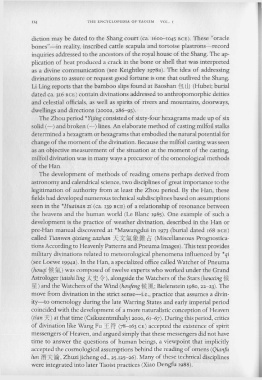Page 154 - The Encyclopedia of Taoism v1_A-L
P. 154
II4 THE ENCYCLOPE DIA OP TAOISM VOL. I
diction may be dated to the Shang court (ca. 1600-1045 BCE). These "oracle
bones"-in reality, inscribed cattle scapula and tortoise plastrons- record
inquiries addressed to the ancestors of the royal house of the Shang. The ap-
plication of heat produced a crack in the bone or shell that was interpreted
as a divine communication (see Keightley 1978a). The idea of addressing
divinations to assure or request good fortune is one that outlived the Shang.
Li Ling reports that the bamboo slips found at Baoshan -EL ill (Hubei; burial
dated ca. 316 BCE) contain divinations addressed to anthropomorphic deities
and celestial officials, as well as spirits of rivers and mountains, doorways,
dwellings and directions (2000a, 286- 93).
The Zhou period *Yijing consisted of sixty-four hexagrams made up of six
solid (- ) and broken (--) lines. An elaborate method of casting milfoil stalks
determined a hexagram or hexagrams that embodied the natural potential for
change of the moment of the divination. Because the milfoil casting was seen
as an objective measurement of the situation at the moment of the casting,
rnilfoil divination was in many ways a precursor of the omenological methods
of the Han.
The development of methods of reading omens perhaps derived from
astronomy and calendrical science, two disciplines of great importance to the
legitimation of authority from at least the Zhou period. By the Han, these
fields had developed numerous technical subdisciplines based on assumptions
seen in the *Huainan zi (ca. 139 BCE) of a relationship of resonance between
the heavens and the human world (Le Blanc 1985). One example of such a
development is the practice of weather divination, described in the Han or
pre-Han manual discovered at *Mawangdui in 1973 (burial dated 168 BCE)
called Tianwen qixiang zazhan :;R)(*t~~ cS" (Miscellaneous Prognostica-
tions According to Heavenly Patterns and Pneuma Images). This text provides
military divinations related to meteorological phenomena influenced by *qi
(see Loewe 1994a). In the Han, a specialized office called Watcher of Pneuma
(houqi f~~) was composed of twelve experts who worked under the Grand
Astrologer (taishi ling ,*.se 4-), alongside the Watchers of the Stars (houxing f~
£) and the Watchers of the Wind (houfeng f~JIal; Bielenstein 1980,22- 23). The
move from divination in the strict sense-i.e., practice that assumes a divin-
ity- to omenology during the late Warring States and early imperial period
coincided with the development of a more naturalistic conception of Heaven
(tian :;R) at that time (Csikszentmihalyi 2000,61-67). During this period, critics
of divination like Wang Fu .::E~ (78- 163 CE) accepted the existence of spirit
messengers of Heaven, and argued simply that these messengers did not have
time to answer the questions of human beings, a viewpoint that implicitly
accepted the cosmological assumptions behind the reading of omens (Qianju
lun :i! -lIifU, Zhuzijicheng ed., 25.125- 26). Many of these technical disciplines
were integrated into later Taoist practices (Xiao Dengfu 1988).

